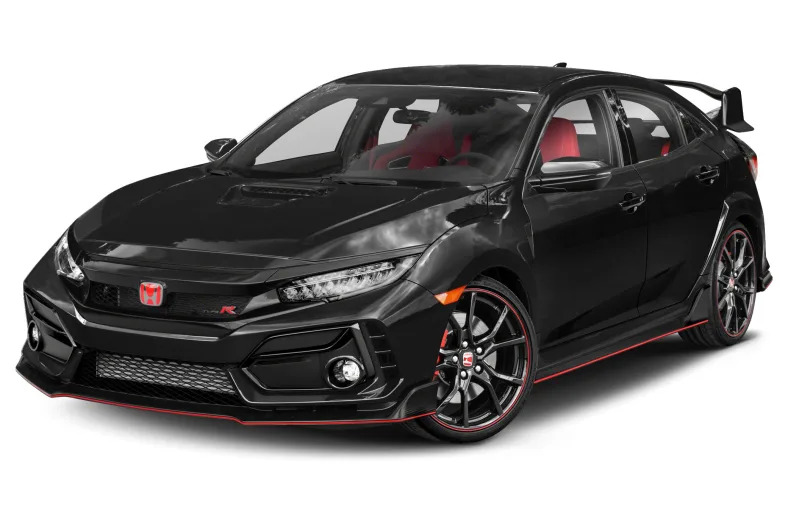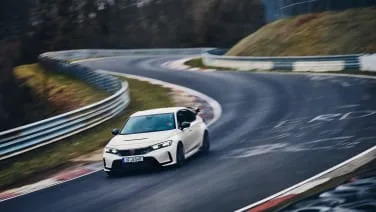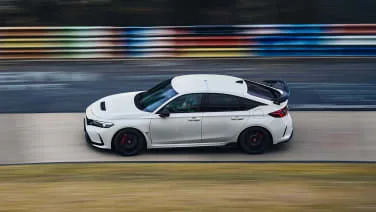2020 Honda Civic Type R
At three years old, the 2020 Honda Civic Type R is getting its first midcycle refresh. You’ll recognize it by its body color grille accents, a bigger grille opening and a little less mesh over some of the fake vents. But it’s the mechanical tweaks and added features that make the newest Type R better than before in almost every way, and slightly worse in another. Under the skin, Honda has focused on brakes and suspension. The new Type R now has two-piece rotors that Honda says dissipate heat better. While we didn’t notice any major improvements on the street from the rotors, we were pleased by the new pedal tweaks. Travel has been reduced for more rapid response, which is clearly noticeable. There’s basically no dead zone in the pedal anymore. It provides a firm, communicative feel, and it’s a breeze to dial in the exact amount of stopping power you want. The front suspension has lower-friction ball joints, and there are new bushings front and rear, which Honda claims provides better steering feel and stability in corners. Again, on the street that extra stability is hard to discover, but the wheel does seem to tell your fingertips a little bit more, particularly in the sportiest +R mode. Combined with its millimeter precision, something shared with last year’s car, the Type R is one of the best steering cars in its class. The adaptive suspension has been updated as well, most notably with new control software that reads input from various sensors 10 times quicker than before to consequently improve handling and ride quality. The settings have also been generally retuned to feel stiffer in the sportiest “+R” mode and more compliant in the soft “Comfort” mode. Certainly, the +R setting is stiff. On the highly textured roads of southeast Michigan, it was almost unusable. Series of bumps had the car bouncing and bucking, which could be disconcerting on fast, curving highway ramps. It did virtually eliminate body roll, though, so we’re certain it would be the best choice for race tracks, autocross courses and smooth roads. For around Detroit, though, the default “Sport” setting was the sweet spot for enthusiastic driving, giving a bit more compliance without adding much body roll. When it was time to just cruise, Comfort mode shone, offering a smooth ride that would seem impossible to achieve with the huge 20-inch wheels and rubber band tires. You do notice a bit of roll in this mode, but the car still reacts quickly and confidently even in this setting. Also, regardless of setting, the Civic Type R feels light, tossable and communicative. It’s a breeze to balance it in corners, reducing throttle to tuck into a corner, and adding it back to straighten it out. Although the bigger grille and an updated radiator core provides extra cooling for 2020, the turbocharged 2.0-liter four-cylinder remains the same, producing 305 horsepower and 295 pound-feet of torque. It pulls hard to redline, and can even break the front …
Full Review
At three years old, the 2020 Honda Civic Type R is getting its first midcycle refresh. You’ll recognize it by its body color grille accents, a bigger grille opening and a little less mesh over some of the fake vents. But it’s the mechanical tweaks and added features that make the newest Type R better than before in almost every way, and slightly worse in another. Under the skin, Honda has focused on brakes and suspension. The new Type R now has two-piece rotors that Honda says dissipate heat better. While we didn’t notice any major improvements on the street from the rotors, we were pleased by the new pedal tweaks. Travel has been reduced for more rapid response, which is clearly noticeable. There’s basically no dead zone in the pedal anymore. It provides a firm, communicative feel, and it’s a breeze to dial in the exact amount of stopping power you want. The front suspension has lower-friction ball joints, and there are new bushings front and rear, which Honda claims provides better steering feel and stability in corners. Again, on the street that extra stability is hard to discover, but the wheel does seem to tell your fingertips a little bit more, particularly in the sportiest +R mode. Combined with its millimeter precision, something shared with last year’s car, the Type R is one of the best steering cars in its class. The adaptive suspension has been updated as well, most notably with new control software that reads input from various sensors 10 times quicker than before to consequently improve handling and ride quality. The settings have also been generally retuned to feel stiffer in the sportiest “+R” mode and more compliant in the soft “Comfort” mode. Certainly, the +R setting is stiff. On the highly textured roads of southeast Michigan, it was almost unusable. Series of bumps had the car bouncing and bucking, which could be disconcerting on fast, curving highway ramps. It did virtually eliminate body roll, though, so we’re certain it would be the best choice for race tracks, autocross courses and smooth roads. For around Detroit, though, the default “Sport” setting was the sweet spot for enthusiastic driving, giving a bit more compliance without adding much body roll. When it was time to just cruise, Comfort mode shone, offering a smooth ride that would seem impossible to achieve with the huge 20-inch wheels and rubber band tires. You do notice a bit of roll in this mode, but the car still reacts quickly and confidently even in this setting. Also, regardless of setting, the Civic Type R feels light, tossable and communicative. It’s a breeze to balance it in corners, reducing throttle to tuck into a corner, and adding it back to straighten it out. Although the bigger grille and an updated radiator core provides extra cooling for 2020, the turbocharged 2.0-liter four-cylinder remains the same, producing 305 horsepower and 295 pound-feet of torque. It pulls hard to redline, and can even break the front …
Hide Full Review
Hide Full Review
Retail Price
$36,995 - $36,995
MSRP / Window Sticker Price
| Engine | 2.0L I-4 |
| MPG | Up to 22 city / 28 highway |
| Seating | 4 Passengers |
| Transmission | 6-spd man w/OD |
| Power | 306 @ 6500 rpm |
| Drivetrain | front-wheel |
| Curb Weight | 3,121 lbs |
Smart Buy Program is powered by 





